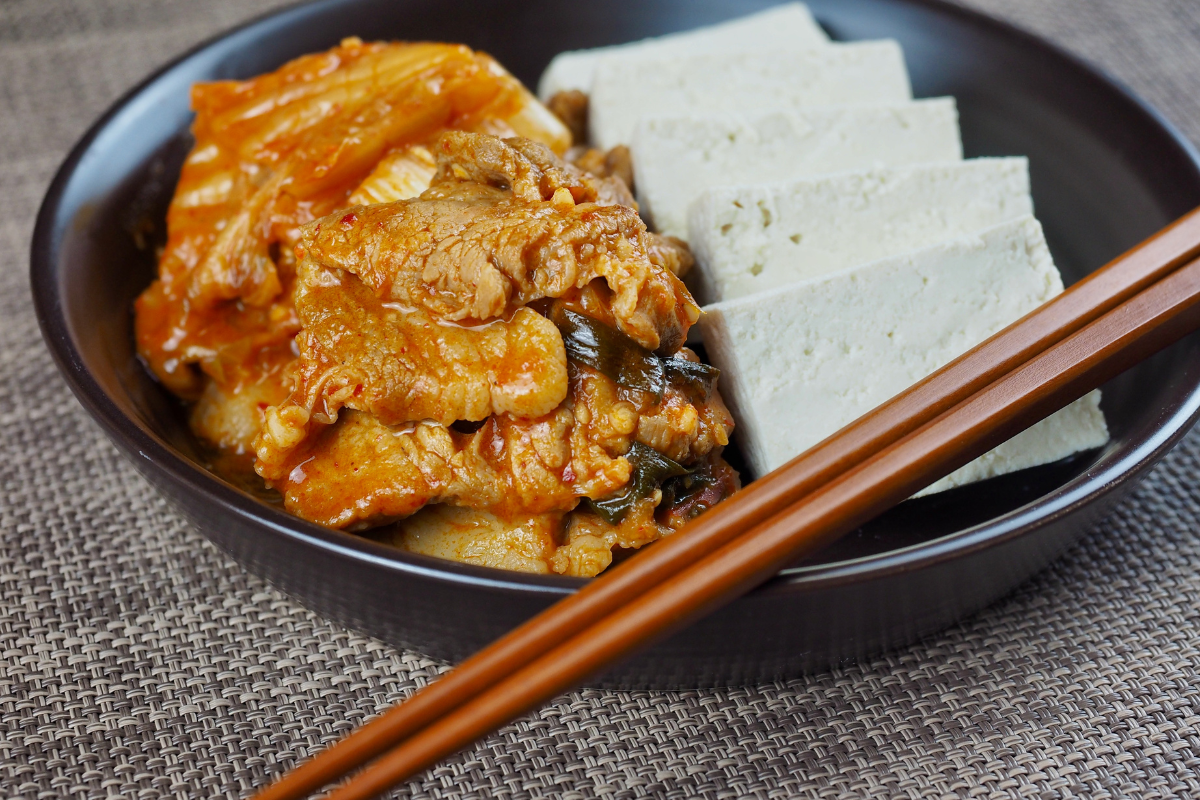The Ultimate Guide To Makgeolli (Korean Rice Wine)
Learn all about this traditional Korean wine, from its history to how to make it!

Makgeolli is a traditional Korean alcoholic beverage made from fermented rice. It has a milky, off-white color and a slightly sweet, tangy taste, with a creamy texture. This drink typically contains about 6-8% alcohol by volume and is often served in a bowl or a kettle, allowing people to pour it into individual cups. Makgeolli's popularity has endured for centuries in Korea, celebrated for its refreshing taste and nutritional benefits, including a rich content of probiotics due to the fermentation process. Read on to learn how to make makgeolli and what foods pair well with different types of makgeolli!
History

A family is seen with a hangari (Korean fermenting vessel) of makgeolli
(Picture source: Yeonhap News)
Makgeolli's origins trace back to the Goryeo Dynasty (918–1392) in Korea, though its consumption likely predates recorded history, making it one of the oldest alcoholic beverages in Korea. It was traditionally made by farmers using a simple brewing method that involved fermenting steamed rice with nuruk, a Korean fermentation starter. This process allowed natural yeasts and beneficial bacteria to ferment the rice, producing alcohol and giving makgeolli its characteristic tangy flavor and milky appearance.

Farmers enjoying makgeolli during their lunch break
(Picture source: National Archives of Korea)
Initially, makgeolli was a homemade drink consumed by farmers, serving as a source of nutrition and refreshment during hard labor in the fields. It was considered the drink of the common people, in contrast to more refined liquors reserved for the aristocracy. Over time, its popularity spread across all levels of Korean society, becoming a staple beverage for various occasions, including celebrations, religious ceremonies, and as a daily refreshment. The simplicity of its ingredients and brewing process made makgeolli an accessible and beloved drink throughout Korean history.
How to Make Makgeolli
Making makgeolli at home involves a simple fermentation process, though it requires patience and attention to detail. Here's a basic outline of how to make makgeolli:
Ingredients:
- 2 cups of sweet rice (also known as glutinous rice)
- Water, for soaking and steaming
- 1 cup of nuruk (a traditional Korean fermentation starter)
- Water, for mixing (approximately 4 cups, but this might vary)
Equipment:
- Large bowl for soaking rice
- Steamer
- Fermentation jar or container
- Cheesecloth or fine mesh for straining
Instructions:
1. Soak the Rice:
- Rinse the sweet rice under cold water until the water runs clear.
- Soak the rice in water for at least 8 hours, or overnight.
2. Steam the Rice:
- Drain the rice and steam it for about 40 minutes, or until it's fully cooked and sticky. Ensure the rice is not too wet or mushy.
3. Cool the Rice:
- Spread the steamed rice out on a tray or large plate to cool to room temperature.
4. Prepare the Fermentation Mixture:
- In a large bowl, mix the cooled rice with nuruk. Gradually add water and mix thoroughly. The consistency should be thick but stirrable.
5. Ferment:
- Transfer the mixture to a fermentation jar or container. Cover the container with a breathable cloth or lid, allowing gases to escape while keeping contaminants out.
- Store the container in a warm, dark place. The ideal temperature for fermentation is around 25°C (77°F).
6. Stir Daily:
- Stir the mixture once a day for the first few days to help distribute the yeast and prevent mold from forming.
7. Fermentation Duration:
- Allow the mixture to ferment for at least 7 to 10 days. Taste it periodically; once it reaches your desired balance of sweetness and tanginess, it's ready for the next step.
8. Strain:
- Strain the mixture through a cheesecloth or a fine mesh to separate the liquid makgeolli from the rice solids. The liquid is your makgeolli, and the solids can be used for other recipes or discarded.
9. Serve or Store:
- Makgeolli can be served immediately or stored in the refrigerator to stop the fermentation process. It's best enjoyed chilled and should be consumed within a week for the best taste.
Notes:
- The alcohol content and sweetness will vary based on the length of fermentation. Longer fermentation results in less sweetness and higher alcohol content.
- Homemade makgeolli is natural and free of preservatives, so it's important to store it properly and consume it while it's fresh.
Making makgeolli at home can be a rewarding experience, allowing you to appreciate the traditional Korean brewing culture. Enjoy the process and the delicious result!
Want to learn all about this unique Korean drink while tasting different types of makgeolli? Join this makgeolli tasting to learn all about it from an expert makgeolli connoisseur!
Check out the experience here!
Common Foods Eaten with Makgeolli
Pajeon (Korean Pancake)

A savory pancake filled with green onions and sometimes seafood or kimchi. The crispy texture and savory flavors of pajeon complement the slightly sweet and tangy taste of makgeolli perfectly. All types of jeon are enjoyed with makgeolli (kimchi pancakes, etc.)
Bossam (Boiled Pork Wraps)

Tender, boiled pork served with fresh, crisp leaves (such as lettuce or perilla leaves) for wrapping, along with side dishes like kimchi and garlic. The combination of the fatty pork and the refreshing makgeolli cleanses the palate and enhances the dining experience.
Dubu Kimchi (Tofu with Stir-fried Kimchi)

This dish features soft, fresh tofu served with stir-fried kimchi and sometimes pork. The soft, mild tofu balances the spicy and sour flavors of the kimchi, creating a harmonious dish. Dubu Kimchi pairs excellently with makgeolli, as the creamy and slightly sweet notes of the drink complement the dish's spicy and umami flavors, making for a satisfying and balanced meal.
Why do Korean drink makgeolli when it rains?
The tradition of drinking makgeolli on rainy days in Korea is a cultural practice that holds both sentimental and practical reasons.

One of the most cited reasons is the sound similarity between the Korean word for rain, "비 (bi)," and the sizzling sound of Korean pancakes (jeon, 전) cooking, which is "지지직 (jijijik)." The idea is that the sound of rain makes people crave jeon, a popular accompaniment to makgeolli. Here's a deeper look into why this tradition is cherished:
- Atmospheric Comfort: Rainy weather often brings a sense of nostalgia and comfort, especially in the countryside. The sound of rain can evoke a cozy feeling, encouraging people to gather indoors and share warm, comforting food and drinks. Makgeolli, with its slightly sweet and tangy flavor, complements this atmosphere perfectly, providing warmth and relaxation.
- Culinary Pairing: As mentioned, the pairing of makgeolli with jeon is a classic combination. The rainy weather serves as a perfect excuse to enjoy this pairing. The crispy, savory jeon contrasts delightfully with the smooth, refreshing makgeolli, creating a satisfying culinary experience that is particularly enjoyable on a damp, chilly day.
- Social Bonding: Drinking makgeolli and eating jeon on a rainy day is also a social activity that brings people together. It's an opportunity to pause from the hustle and bustle of daily life and spend quality time with family and friends, sharing stories and laughter over simple, homemade food and drinks.
- Historical and Cultural Significance: Historically, makgeolli was a drink of the working class, including farmers who would appreciate the rain for the benefits it brought to their crops. Drinking makgeolli on a rainy day connects people to their agricultural roots and celebrates the importance of rain in sustaining life and livelihoods.
This tradition encapsulates the Korean concept of "jeong" (정), a deep feeling of affection and camaraderie. It's more than just the act of drinking; it's about the warmth of shared experiences and the comfort of tradition in the face of the simple, natural phenomenon of rain.
Deep dive into the world of makgeolli on a tour in Korea or at a Korean pocha (Korean bar)! Learn all about one of Korea's most loved drinks!
We hope that you can enjoy a ! If you have any questions or concerns, please leave a comment below or send us an email at help@creatrip.com! You can follow us on Instagram, TikTok, Twitter, and Facebook to stay updated on all things Korea!